Derfner Judaica Museum and The Art Collection
The inaugural exhibition, Tradition and Remembrance: Treasures of the Derfner Judaica Museum, at the Hebrew Home in Riverdale is a stunning presentation of close to 250 objects that sweeps through Jewish art history from the eighteenth century to contemporary times.
The depth and breath of the collection is truly impressive, shown in an especially good light by the curatorial skill of Susan Chevlowe, Chief Curator and Director, who skillfully manipulates the elegant new 5,000 square foot exhibition space in the Jacob Reingold Pavilion.
Previously the Hebrew Home’s vast art collection (started almost 40 years ago by Jacob Reingold and reviewed August, 2000) was distinct from the Judaica Museum Ralph and Leuba Baum Collection (reviewed December, 2000). Now they have been merged under the watchful eye of Susan Chevlowe and the Museum has opened in a beautiful, bright new modern exhibition space.
Generally the museum is organized thematically, starting with eight glass cases of objects from the Bezalel School featuring wonderful silver filigree and damascene (inlayed gold and silver) Judaica. Works by Boris Schatz and Ludwig Wolpert are featured among many others. Further along an entire display case is devoted to selections of European silverwork from the Ralph and Leuba Baum Collection.
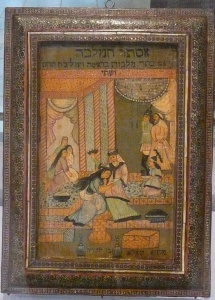
A series of clear glass displays concentrate on Rosh Hashana, Hanukah, Purim, Passover and Shabbat. In these cases, practically right next to one another, are two of the finest masterpieces of the entire museum. One is a panel painting by Persian artist Ben Yehuda from about 1730. An elaborately inlayed frame surrounds the painted ivory panel illustrating the verse in Megillas Esther 3:17; “So he (the King) set a royal crown on her head and made her queen instead of Vashti.” In the flattened space typical of Persian miniatures a curious drama unfolds. King Ahasuerus is about to crown Esther with his right hand as she kneels before him grasping his left hand. This gesture alone is intriguing, indicating a kind of affection between the king and his forced queen. We see three anxious maidens behind Esther who balance the left side with the kneeling servant and two courtiers standing on the right. Set apart from the coronation they appear to be conspiring, one with his back to us, hands confidently clasped behind his back. The Persian artist Ben Yehuda has taken the simple event of the crowning of Esther and caused it to narrate forward into the unfolding intrigue in which Queen Esther becomes the linchpin to save the entire Jewish people.
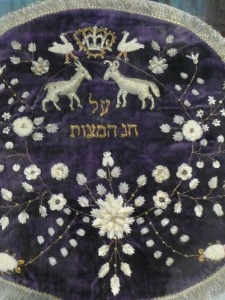
Just to the right is an entirely different kind of masterpiece from the Girls’ Orphan Home in Jerusalem, created in the late 19th century. This rather large matzah bag is made of velvet meticulously embroidered with metallic thread, sequins, beads and fish scales. While the folk design of two geese flanking the crown of Torah, atop a goat and a ram, set amidst a floral design featuring flowers, leaves, little bugs, and fish is undoubtedly charming, it is the stunning quality of the delicate craftsmanship that overwhelms the viewer. Master fabric artist Ita Aber exclaimed, “The work is spectacular!”
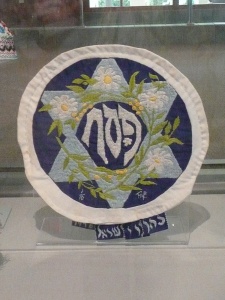
Circulating around the perimeter there are four additional clear glass cases presenting Judaic works of textiles, amulets, circumcision, marriage and Torah mantles. The aforementioned fabric artist Ita Aber is represented by two matzah covers. The round one, designed with Tsirl Waletsky, features a charming Spring themed design that humorously designates the three pouches for the three ceremonial matzahs as “Cohen, Levi and Yisroel.” As the seder clearly tells us, each kind of Jew has a role to play in our march towards redemption and freedom.
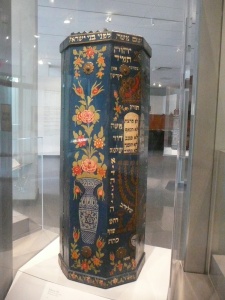
The light and airy central exhibition area is constructed of green translucent glass set in a stainless steel structure and continues the display of Torah ornaments, crowns, finials and the extensive collection of Torah pointers. Of particular note are the three wooden Sephardic Torah containers. Each tik is a unique design, exploring the possibilities inherent in the combination of an architectural concept (a house for the Holy Torah) and the pictorial opportunities of a painted surface. The tik from Kashan, Persia is a folk masterpiece displaying a wonderful combination of charm and piety. The floral motif expresses optimism in the yearning for Zion and the restoration of the Temple reflected by the seven branched menorah, itself resting on a base of the Ten Commandments of Torah.
Around the outside of the curved central display area are collections of more personal Judaica including selections from the Belle Rosenbaum mezuzah collection, silver siddur covers and nineteenth century tallis and tefillin covers. I have of course only mentioned a handful of the objects that struck me during my visit. There are many other objects of note, all of which are worthy of consideration, especially since the setting of the museum is so serene, overlooking the Hebrew Home’s expansive lawn and the Hudson River beyond.
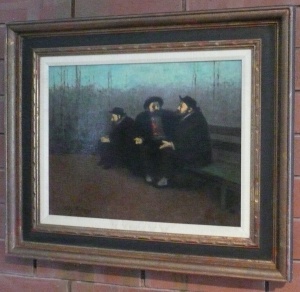
As I was leaving I noticed a little painting right at the entrance that in a funny way summed up my experience of the Derfner Judaica Museum. The painting is by Tully Filmus, a realist and portrait painter who passed away in 1998 at the age of 94. Born in Bessarabia (Moldova) he came to America and became a successful artist, even sharing a studio with Willem de Kooning in the 1930’s. He seems to have frequently done Jewish themes from the “Old Country.” This modest painting, Three Bearded Men (ca. 1960), is not untypical of his Jewish-themed works in its apparent sentimentality and clichéd view of Jewish life. And yet the starkness, bold composition and repetition of sets of three make it intriguing. What is it about the way Jews create dialogue where each of these men are incomplete without each other? In the painting this is witnessed by the fact that each individual has only one hand so the two men speaking to each other are made into one by their shared hands (and shared two feet as well). But then what about the old guy facing away by himself at the end of the bench? Does his presence somehow complete the incomplete pair sitting next to him? Or does he just complicate it all. Whatever the answer, one thing is sure, the painting causes us to question the entire set of relationships, so Jewish in its active and creative doubt.
In a very meaningful way the Filmus painting sharply contrasts with the spirit of most of the Judaica the museum presents. The very nature of Judaica; craft and artwork used in the daily functioning of a Jewish life, is positive and affirming. Doubt, questioning, analysis and probing are seldom in the lexicon of Judaica. That is perhaps why a visit to this museum is such a positive and pleasant experience. We realize that after we spend much of our Jewish life learning, questioning and challenging the complexities of life we precede day after day to do the mitzvahs God has commanded us with exactly the same kind of Judaica so beautifully presented here.
Derfner Judaica Museum and The Art Collection
The Hebrew Home at Riverdale – Jacob Reingold Pavilion
5901 Palisade Avenue, Riverdale, NY